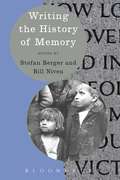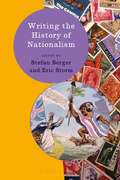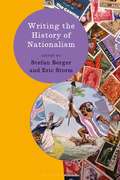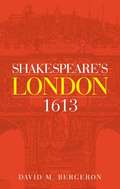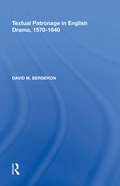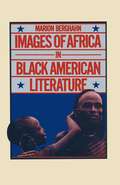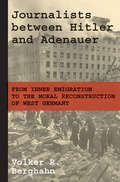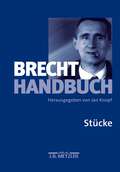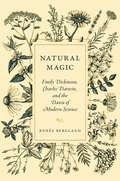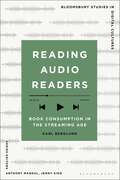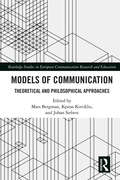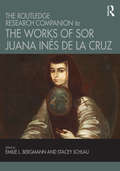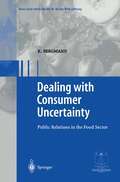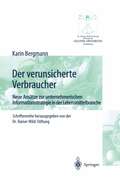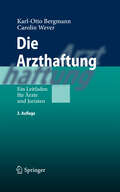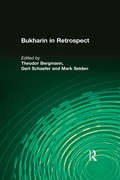- Table View
- List View
Writing the History of Memory (Writing History)
by Stefan Berger Bill NivenHow objective are our history books? This addition to the Writing History series examines the critical role that memory plays in the writing of history.This book includes:- Essays from an international team of historians, bringing together analysis of forms of public history such as museums, exhibitions, memorials and speeches- Coverage of the ancient world to the present, on topics such as oral history and generational and collective memory- Two key case studies on Holocaust memorialisation and the memory of Communism
Writing the History of Memory (Writing History)
by Stefan Berger Bill NivenHow objective are our history books? This addition to the Writing History series examines the critical role that memory plays in the writing of history.This book includes:- Essays from an international team of historians, bringing together analysis of forms of public history such as museums, exhibitions, memorials and speeches- Coverage of the ancient world to the present, on topics such as oral history and generational and collective memory- Two key case studies on Holocaust memorialisation and the memory of Communism
Writing the History of Nationalism (Writing History)
by Stefan Berger Eric StormWhat is nationalism and how can we study it from a historical perspective? Writing the History of Nationalism answers this question by examining eleven historical approaches to nationalism studies in theory and practice.An impressive cast of contributors cover the history of nationalism from a wide range of thematic approaches, from traditional modernist and Marxist perspectives to more recent debates around gender. postcolonialism and the global turn in history writing.This book is essential reading for undergraduate students of history, politics and sociology wanting to understand the complex yet fascinating history of nationalism.
Writing the History of Nationalism (Writing History)
by Stefan Berger Eric StormWhat is nationalism and how can we study it from a historical perspective? Writing the History of Nationalism answers this question by examining eleven historical approaches to nationalism studies in theory and practice.An impressive cast of contributors cover the history of nationalism from a wide range of thematic approaches, from traditional modernist and Marxist perspectives to more recent debates around gender. postcolonialism and the global turn in history writing.This book is essential reading for undergraduate students of history, politics and sociology wanting to understand the complex yet fascinating history of nationalism.
Shakespeare's London 1613
by David M. BergeronShakespeare’s London 1613 offers for the first time a comprehensive ‘biography’ of this crucial year in English history. The book examines political and cultural life in London, including the Jacobean court and the city, which together witnessed an exceptional outpouring of cultural experiences and transformative political events. The royal family had to confront the sudden death of Prince Henry, heir apparent to the throne, which provoked unparalleled grief. Meanwhile, an unprecedented number of plays performed at court helped move the country away from sadness to the happy occasion of Princess Elizabeth’s marriage to a German prince. Shakespeare’s productions dominated London’s cultural landscape, while other playwrights, writers and printers produced an extraordinary number of books. Readers interested in literature, cultural history, and the royal family will find in this book a rich and accessible account of this monumental year.
Textual Patronage in English Drama, 1570-1640
by David M. BergeronThrough an investigation of the dedications and addresses from various printed plays of the English Renaissance, the author recuperates the richness of these prefaces and connects them to the practice of patronage. The prefatory matter discussed ranges from the printer John Day's address to readers (the first of its kind) in the 1570 edition of Gorboduc to Richard Brome's dedication to William Seymour and address to readers in his 1640 play, Antipodes. The study includes discussion of prefaces in plays by Shakespeare's contemporaries as well as Shakespeare himself, among them Marston, Jonson, and Heywood. The author uses these prefaces to show that English playwrights, printers and publishers looked in two directions, toward aristocrats and toward a reading public, in order to secure status for and dissemination of dramatic texts. The author points out that dedications and addresses to readers constitute obvious signs that printers, publishers and playwrights in the period increasingly saw these dramatic texts as occupying a rightful place in the humanistic and commercial endeavor of book production.
Textual Patronage in English Drama, 1570-1640
by David M. BergeronThrough an investigation of the dedications and addresses from various printed plays of the English Renaissance, the author recuperates the richness of these prefaces and connects them to the practice of patronage. The prefatory matter discussed ranges from the printer John Day's address to readers (the first of its kind) in the 1570 edition of Gorboduc to Richard Brome's dedication to William Seymour and address to readers in his 1640 play, Antipodes. The study includes discussion of prefaces in plays by Shakespeare's contemporaries as well as Shakespeare himself, among them Marston, Jonson, and Heywood. The author uses these prefaces to show that English playwrights, printers and publishers looked in two directions, toward aristocrats and toward a reading public, in order to secure status for and dissemination of dramatic texts. The author points out that dedications and addresses to readers constitute obvious signs that printers, publishers and playwrights in the period increasingly saw these dramatic texts as occupying a rightful place in the humanistic and commercial endeavor of book production.
Biography Between Structure and Agency: Central European Lives in International Historiography (Studies in German History #9)
by Volker Berghahn Simone LässigWhile bookstore shelves around the world have never ceased to display best-selling “life-and-letters” biographies in prominent positions, the genre became less popular among academic historians during the Cold War decades. Their main concern then was with political and socioeconomic structures, institutions, and organizations, or—more recently—with the daily lives of ordinary people and small communities. The contributors to this volume—all well known senior historians—offer self-critical reflections on problems they encountered when writing biographies themselves. Some of them also deal with topics specific to Central Europe, such as the challenges of writing about the lives of both victims and perpetrators. Although the volume concentrates on European historiography, its strong methodological and conceptual focus will be of great interest to non-European historians wrestling with the old “structure-versus-agency” question in their own work. Contributors: Volker R. Berghahn, Hartmut Berghoff, Hilary Earl, Jan Eckel, Willem Frijhoff, Ian Kershaw, Simone Lässig, Karl Heinrich Pohl, John C. G. Röhl, Angelika Schaser, Joachim Radkau, Cornelia Rauh-Kühne, Mark Roseman, Christoph Strupp and Michael Wildt.
Journalists between Hitler and Adenauer: From Inner Emigration to the Moral Reconstruction of West Germany
by Volker R. BerghahnThe moral and political role of German journalists before, during, and after the Nazi dictatorshipJournalists between Hitler and Adenauer takes an in-depth look at German journalism from the late Weimar period through the postwar decades. Illuminating the roles played by journalists in the media metropolis of Hamburg, Volker Berghahn focuses on the lives and work of three remarkable individuals: Marion Countess Dönhoff, distinguished editor of Die Zeit; Paul Sethe, “the grand old man of West German journalism”; and Hans Zehrer, editor in chief of Die Welt.All born before 1914, Dönhoff, Sethe, and Zehrer witnessed the Weimar Republic’s end and opposed Hitler. When the latter seized power in 1933, they were, like their fellow Germans, confronted with the difficult choice of entering exile, becoming part of the active resistance, or joining the Nazi Party. Instead, they followed a fourth path—“inner emigration”—psychologically distancing themselves from the regime, their writing falling into a gray zone between grudging collaboration and active resistance. During the war, Dönhoff and Sethe had links to the 1944 conspiracy to kill Hitler, while Zehrer remained out of sight on a North Sea island. In the decades after 1945, all three became major figures in the West German media. Berghahn considers how these journalists and those who chose inner emigration interpreted Germany’s horrific past and how they helped to morally and politically shape the reconstruction of the country.With fresh archival materials, Journalists between Hitler and Adenauer sheds essential light on the influential position of the German media in the mid-twentieth century and raises questions about modern journalism that remain topical today.
Journalists between Hitler and Adenauer: From Inner Emigration to the Moral Reconstruction of West Germany
by Volker R. BerghahnThe moral and political role of German journalists before, during, and after the Nazi dictatorshipJournalists between Hitler and Adenauer takes an in-depth look at German journalism from the late Weimar period through the postwar decades. Illuminating the roles played by journalists in the media metropolis of Hamburg, Volker Berghahn focuses on the lives and work of three remarkable individuals: Marion Countess Dönhoff, distinguished editor of Die Zeit; Paul Sethe, “the grand old man of West German journalism”; and Hans Zehrer, editor in chief of Die Welt.All born before 1914, Dönhoff, Sethe, and Zehrer witnessed the Weimar Republic’s end and opposed Hitler. When the latter seized power in 1933, they were, like their fellow Germans, confronted with the difficult choice of entering exile, becoming part of the active resistance, or joining the Nazi Party. Instead, they followed a fourth path—“inner emigration”—psychologically distancing themselves from the regime, their writing falling into a gray zone between grudging collaboration and active resistance. During the war, Dönhoff and Sethe had links to the 1944 conspiracy to kill Hitler, while Zehrer remained out of sight on a North Sea island. In the decades after 1945, all three became major figures in the West German media. Berghahn considers how these journalists and those who chose inner emigration interpreted Germany’s horrific past and how they helped to morally and politically shape the reconstruction of the country.With fresh archival materials, Journalists between Hitler and Adenauer sheds essential light on the influential position of the German media in the mid-twentieth century and raises questions about modern journalism that remain topical today.
Brecht-Handbuch: Band 1: Stücke
by Brigitte Bergheim Joachim Lucchesi"Vierzig Jahre, und mein Werk ist der Abgesang des Jahrtausends", schrieb Bertolt Brecht 1920. Am Beginn des neuen Jahrtausends hat sich die überragende Bedeutung Brechts nicht nur für die deutsche Literatur, sondern auch für die Weltliteratur erwiesen. Das "Brecht-Handbuch" wird nun in vollständig neu bearbeiteter und erweiterter Form vorgelegt. Es basiert auf dem Wissensstand der Großen Berliner und Frankfurter Ausgabe der Werke Bertolt Brechts (1988-2000), und es bietet in fünf Bänden eine Einführung in das Gesamtwerk, präsentiert den aktuellen Forschungsstand, stellt ein benutzerfreundliches, leicht überschaubares und zuverlässiges Nachschlagewerk dar. In über 250 monographisch angelegten Einzelartikeln, von 68 Brecht-Forschern des In- und Auslands erarbeitet, werden Überblicke über Zeitabschnitte des Brechtschen Schaffens und Stilentwicklungen gegeben.
Natural Magic: Emily Dickinson, Charles Darwin, and the Dawn of Modern Science
by Renée BerglandA captivating portrait of the poet and the scientist who shared an enchanted view of natureEmily Dickinson and Charles Darwin were born at a time when the science of studying the natural world was known as natural philosophy, a pastime for poets, priests, and schoolgirls. The world began to change in the 1830s, while Darwin was exploring the Pacific aboard the Beagle and Dickinson was a student in Amherst, Massachusetts. Poetry and science started to grow apart, and modern thinkers challenged the old orthodoxies, offering thrilling new perspectives that suddenly felt radical—and too dangerous for women.Natural Magic intertwines the stories of these two luminary nineteenth-century minds whose thought and writings captured the awesome possibilities of the new sciences and at the same time strove to preserve the magic of nature. Just as Darwin&’s work was informed by his roots in natural philosophy and his belief in the interconnectedness of all life, Dickinson&’s poetry was shaped by her education in botany, astronomy, and chemistry, and by her fascination with the enchanting possibilities of Darwinian science. Casting their two very different careers in an entirely fresh light, Renée Bergland brings to life a time when ideas about science were rapidly evolving, reshaped by poets, scientists, philosophers, and theologians alike. She paints a colorful portrait of a remarkable century that transformed how we see the natural world.Illuminating and insightful, Natural Magic explores how Dickinson and Darwin refused to accept the separation of art and science. Today, more than ever, we need to reclaim their shared sense of ecological wonder.
Natural Magic: Emily Dickinson, Charles Darwin, and the Dawn of Modern Science
by Renée BerglandA captivating portrait of the poet and the scientist who shared an enchanted view of natureEmily Dickinson and Charles Darwin were born at a time when the science of studying the natural world was known as natural philosophy, a pastime for poets, priests, and schoolgirls. The world began to change in the 1830s, while Darwin was exploring the Pacific aboard the Beagle and Dickinson was a student in Amherst, Massachusetts. Poetry and science started to grow apart, and modern thinkers challenged the old orthodoxies, offering thrilling new perspectives that suddenly felt radical—and too dangerous for women.Natural Magic intertwines the stories of these two luminary nineteenth-century minds whose thought and writings captured the awesome possibilities of the new sciences and at the same time strove to preserve the magic of nature. Just as Darwin&’s work was informed by his roots in natural philosophy and his belief in the interconnectedness of all life, Dickinson&’s poetry was shaped by her education in botany, astronomy, and chemistry, and by her fascination with the enchanting possibilities of Darwinian science. Casting their two very different careers in an entirely fresh light, Renée Bergland brings to life a time when ideas about science were rapidly evolving, reshaped by poets, scientists, philosophers, and theologians alike. She paints a colorful portrait of a remarkable century that transformed how we see the natural world.Illuminating and insightful, Natural Magic explores how Dickinson and Darwin refused to accept the separation of art and science. Today, more than ever, we need to reclaim their shared sense of ecological wonder.
Reading Audio Readers: Book Consumption in the Streaming Age (Bloomsbury Studies in Digital Cultures)
by Karl BerglundThe first computational study of reading to focus on audiobooks, this book uses a unique and substantial set of reader consumption data to show how audiobooks and digital streaming platforms affect our literary culture. Offering an academic perspective on the kind of user data hoard we associate with tech companies, it asks: when it comes to audiobooks, what do people really read, and how and when do they read it?Tracking hundreds of thousands of readers on the level per user and hour, Reading Audio Readers combines computational methods from cultural analytics with theoretical perspectives from book history, publishing studies, and media studies. In doing so, it provides new insights into reading practices in digital platforms, the effects of the audiobook boom, and the business-models for book publishing and distribution in the age of streamed audio.
Reading Audio Readers: Book Consumption in the Streaming Age (Bloomsbury Studies in Digital Cultures)
by Karl BerglundThe first computational study of reading to focus on audiobooks, this book uses a unique and substantial set of reader consumption data to show how audiobooks and digital streaming platforms affect our literary culture. Offering an academic perspective on the kind of user data hoard we associate with tech companies, it asks: when it comes to audiobooks, what do people really read, and how and when do they read it?Tracking hundreds of thousands of readers on the level per user and hour, Reading Audio Readers combines computational methods from cultural analytics with theoretical perspectives from book history, publishing studies, and media studies. In doing so, it provides new insights into reading practices in digital platforms, the effects of the audiobook boom, and the business-models for book publishing and distribution in the age of streamed audio.
Models of Communication: Theoretical and Philosophical Approaches (Routledge Studies in European Communication Research and Education)
by Mats Bergman K 281 Stas Kirtiklis Johan SiebersModels of Communication offers a timely reassessment of the significance of modelling in media and communication studies. From a rich variety of different perspectives, the collected essays explore the past, present, and future uses of communication models, in ordinary discourses concerning communication as well as in academic research. This book challenges received views of communication models and opens up new paths of inquiry for communication research. By zooming in on the manifestations and purposes of modelling in ordinary discourses on communication as well as in theoretical expositions, the essays collected in this volume cast new light on the problems and prospects of models crafted for the benefit of communication inquiry. Complementing earlier studies of models of communication, the volume digs deep into fundamental epistemological and ontological questions concerning modelling in the communication disciplines; but it also presents several novel models that promise to be of practical use in empirical studies of media and communication. The book is intended for communication scholars and students of media and will also be of interest for related disciplines in the humanities and the social sciences.
Models of Communication: Theoretical and Philosophical Approaches (Routledge Studies in European Communication Research and Education)
by Mats Bergman K 281 Stas Kirtiklis Johan SiebersModels of Communication offers a timely reassessment of the significance of modelling in media and communication studies. From a rich variety of different perspectives, the collected essays explore the past, present, and future uses of communication models, in ordinary discourses concerning communication as well as in academic research. This book challenges received views of communication models and opens up new paths of inquiry for communication research. By zooming in on the manifestations and purposes of modelling in ordinary discourses on communication as well as in theoretical expositions, the essays collected in this volume cast new light on the problems and prospects of models crafted for the benefit of communication inquiry. Complementing earlier studies of models of communication, the volume digs deep into fundamental epistemological and ontological questions concerning modelling in the communication disciplines; but it also presents several novel models that promise to be of practical use in empirical studies of media and communication. The book is intended for communication scholars and students of media and will also be of interest for related disciplines in the humanities and the social sciences.
The Routledge Research Companion to the Works of Sor Juana Inés de la Cruz
by Emilie L. Bergmann Stacey SchlauCalled by her contemporaries the "Tenth Muse," Sor Juana Inés de la Cruz (1648–1695) has continued to stir both popular and scholarly imaginations. While generations of Mexican schoolchildren have memorized her satirical verses, only since the 1970s has her writing received consistent scholarly attention., focused on complexities of female authorship in the political, religious, and intellectual context of colonial New Spain. This volume examines those areas of scholarship that illuminate her work, including her status as an iconic figure in Latin American and Baroque letters, popular culture in Mexico and the United States, and feminism. By addressing the multiple frameworks through which to read her work, this research guide serves as a useful resource for scholars and students of the Baroque in Europe and Latin America, colonial Novohispanic religious institutions, and women’s and gender studies. The chapters are distributed across four sections that deal broadly with different aspects of Sor Juana's life and work: institutional contexts (political, economic, religious, intellectual, and legal); reception history; literary genres; and directions for future research. Each section is designed to provide the reader with a clear understanding of the current state of the research on those topics and the academic debates within each field.
The Routledge Research Companion to the Works of Sor Juana Inés de la Cruz
by Emilie L. Bergmann Stacey SchlauCalled by her contemporaries the "Tenth Muse," Sor Juana Inés de la Cruz (1648–1695) has continued to stir both popular and scholarly imaginations. While generations of Mexican schoolchildren have memorized her satirical verses, only since the 1970s has her writing received consistent scholarly attention., focused on complexities of female authorship in the political, religious, and intellectual context of colonial New Spain. This volume examines those areas of scholarship that illuminate her work, including her status as an iconic figure in Latin American and Baroque letters, popular culture in Mexico and the United States, and feminism. By addressing the multiple frameworks through which to read her work, this research guide serves as a useful resource for scholars and students of the Baroque in Europe and Latin America, colonial Novohispanic religious institutions, and women’s and gender studies. The chapters are distributed across four sections that deal broadly with different aspects of Sor Juana's life and work: institutional contexts (political, economic, religious, intellectual, and legal); reception history; literary genres; and directions for future research. Each section is designed to provide the reader with a clear understanding of the current state of the research on those topics and the academic debates within each field.
Dealing with consumer uncertainty: Public Relations in the Food Sector (Gesunde Ernährung Healthy Nutrition)
by Karin BergmannMy studies on the "uncertain consumer" began with a research project c- ducted by the Dr. Rainer Wild-Stiftung - Foundation for healthy nutrition - on the negative image of processed food. Ever since then I have been asked whether or not growing consumer uncertainty is linked to information po- cies of the food sector and if so, how. Intensive three-year research showed that industrial methods of food production are predestined to result in wayward fears and worry over its healthiness. This is due to the fact that during the process of industrialisation, we gradually passed responsibility for the quality of food into the producers' hands. This, in turn, has resulted in information gaps that we, as the addressees of diverse, often overwhelming and contrad- tory information supplied by varying sources, feel today. We exchanged the daily search for food for the daily search for information long ago. Con- quently, a practical concept for public relations stands at the end of my - search into the uncertain consumer. It accounts for uncertainty regarding processed food as a point of reference for public relations targeted towards various groups. Public relations oriented towards the future calls for the sharing of expert information with all interested consumers. It is the goal of businesses to actively build up trust among the consumers in order to be prepared for new causes for uncertainty appearing periodically. To this day the issue of consumer uncertainty has not lost its topicality.
Der verunsicherte Verbraucher: Neue Ansätze zur unternehmerischen Informationsstrategie in der Lebensmittelbranche (Gesunde Ernährung Healthy Nutrition)
by Karin BergmannDie aktuelle Kommunikationspraxis der Ernährungswirtschaft erzeugt in weiten Teilen der Bevölkerung eine erhebliche Verunsicherung. Eine wirkungsvolle unternehmerische Öffentlichkeitsarbeit in der industriellen Lebensmittelerzeugung benötigt ein neues Konzept für die Kommunikation zwischen Erzeugern, Verarbeitern, Händlern und Endverbrauchern von Lebensmitteln. Die Autorin erklärt, ohne zu pauschalisieren, was Verbraucher verunsichert und welche Konsequenzen Verbraucherverunsicherung für das Ernährungsverhalten hat. Das Buch bietet - basierend auf neuen empirischen Daten und einer repräsentativen Verbraucherbefragung - praxisbezogene Ansätze für eine neue unternehmerische Öffentlichkeitsarbeit, die darauf abzielt, mit informierten Konsumenten anstelle verunsicherter Verbraucher zu kommunizieren.
Die Arzthaftung: Ein Leitfaden für Ärzte und Juristen
by Karl Otto Bergmann Carolin WeverIm Mittelpunkt des Leitfadens stehen die Haftungsfragen der arbeitsteiligen Medizin, die Organisation der Patientenaufklärung und der ärztlichen Dokumentation sowie die Zusammenhänge zwischen Arzthaftung und -versicherung. Um in die Denk- und Verfahrensweise der Zivilgerichte einzuführen, werden 40 Fälle zu zentralen Fragen des ärztlichen Haftungsrechts vorgestellt. Auch neuere Entwicklungen im Arzthaftungsrecht wie z. B. Übertragung ärztlicher Aufgaben an Nichtärzte, Aufklärung bei Medikamentengabe oder Off-Label-Use finden Berücksichtigung.
Bukharin in Retrospect
by Theodor Bergmann Moshe LewinThis volume is the product of an international conference held in the autumn of 1988, around the time Nikolai Bukharin was officially rehabilitated - a benchmark in the history of glasnost and the process of legitimating perestroika. Conference participants from 19 countries, including the USSR and China, took occasion to reconsider the record and legacy of Bukharin as revolutionary, economist and political theorist. They offer a many-sided but critical re-examination of Bolshevism's "internal alternative" to Stalin and Stalinism.
Bukharin in Retrospect
by Theodor Bergmann Moshe LewinThis volume is the product of an international conference held in the autumn of 1988, around the time Nikolai Bukharin was officially rehabilitated - a benchmark in the history of glasnost and the process of legitimating perestroika. Conference participants from 19 countries, including the USSR and China, took occasion to reconsider the record and legacy of Bukharin as revolutionary, economist and political theorist. They offer a many-sided but critical re-examination of Bolshevism's "internal alternative" to Stalin and Stalinism.
